PUBLIC FACILITY
COMPETITION SCHOOL COMPLEX
TEAM
Architect of Record:
Fabienne Bulle
Local Architect:
Bruneau Ghezzi Architectes
Contractor: EGIS
Landscape Architect: Phusis
Location: St Jean, St Barthélemy
Surface: 3500 m2
Budget: 16 000 000 €
Client: Collectivité de St Barthélemy
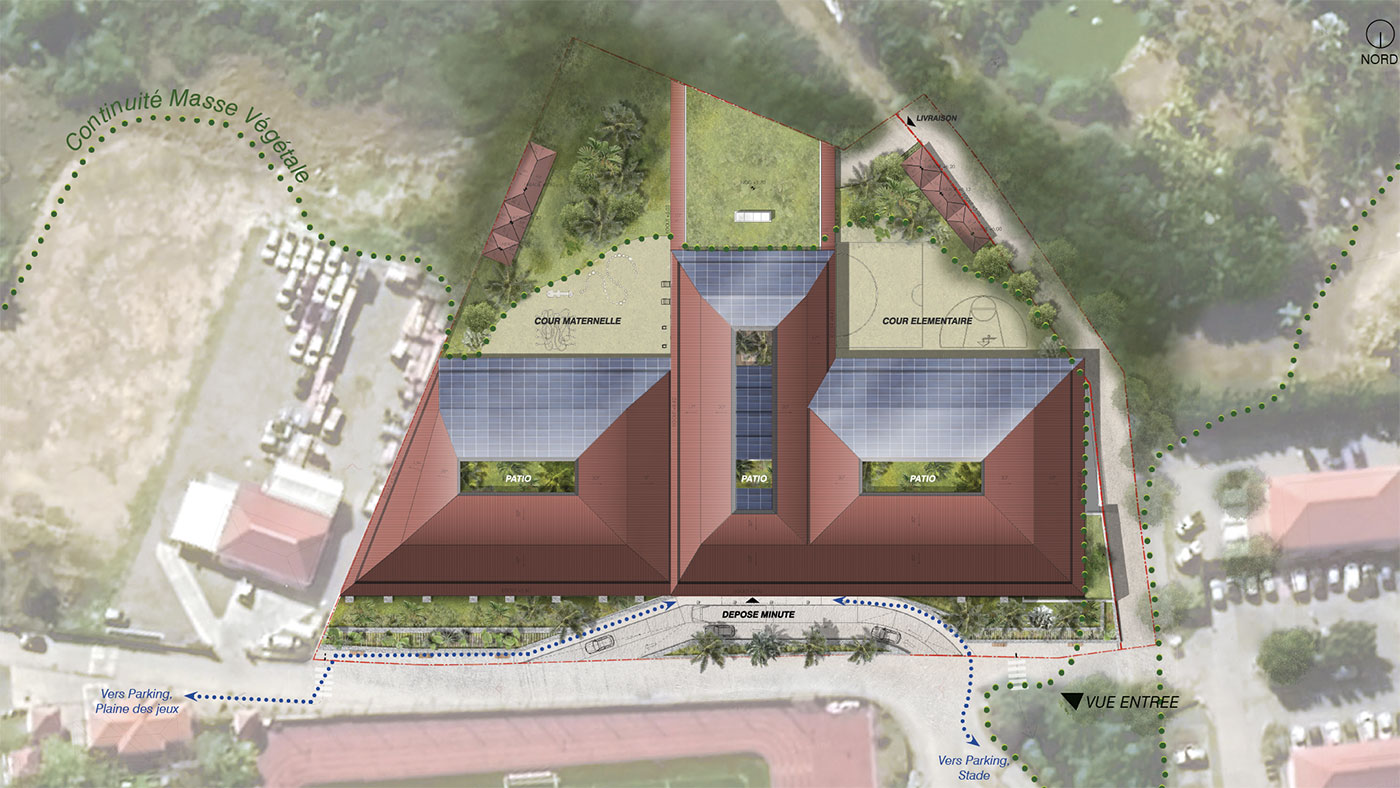
PUBLIC FACILITY
COMPETITION SCHOOL COMPLEX
TEAM
Architect of Record:
Fabienne Bulle
Local Architect:
Bruneau Ghezzi Architectes
Contractor: EGIS
Landscape Architect: Phusis
Location: St Jean, St Barthélemy
Surface: 3500 m2
Budget: 16 000 000 €
Client: Collectivité de St Barthélemy

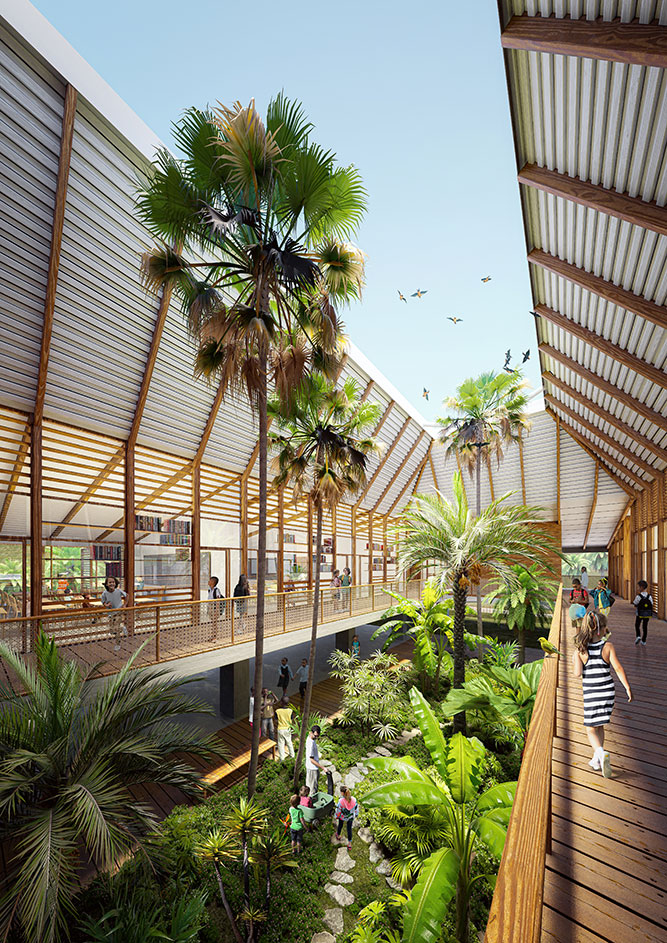
Create A Barrier; Protect The Children
The land intended for this project is flat and ideally located, but faced with several constraints and challenges: flood zone; soil liquefaction; danger and noise from the road; small plot of land with complex shape; dense usage program; limited height; insufficient surface for the building; adjacent activities. The starting point was to create a barrier for protection and education of the children. A barrier to protect access to the site, a barrier to protect the classrooms and the playground. A barrier to protect the project from water, sound, and wind. To conquer the complexity of the site and create our proposal, it was necessary to have a rational and compact response to the challenges. The compact aspect was also the first eco-responsible step of the project: ecology means building but consuming less. To be compact means building more while consuming less, or in other words, building on two levels to economize resources and land. Economizing on the overall footprint would have allowed us to construct the first-phase, fundamental elements of this project to secure and protect the site: place the building away from the road and create totally secure access without impacting traffic in the area. To do so, we designed a raised garden along the frontage on the territorial access road that would protect the facades and provide a safe service road. The building would serve as an institutional rampart from east to west to protect the two structures and their exterior spaces. To the south, the playgrounds at the back open toward hillsides and give the sense of prolonging the limit of the landscape. Additional vegetation in front of the fences add to this illusion. The building is punctuated with three patios, three cocoons.

Create A Barrier; Protect The Children
The land intended for this project is flat and ideally located, but faced with several constraints and challenges: flood zone; soil liquefaction; danger and noise from the road; small plot of land with complex shape; dense usage program; limited height; insufficient surface for the building; adjacent activities. The starting point was to create a barrier for protection and education of the children. A barrier to protect access to the site, a barrier to protect the classrooms and the playground. A barrier to protect the project from water, sound, and wind. To conquer the complexity of the site and create our proposal, it was necessary to have a rational and compact response to the challenges. The compact aspect was also the first eco-responsible step of the project: ecology means building but consuming less. To be compact means building more while consuming less, or in other words, building on two levels to economize resources and land. Economizing on the overall footprint would have allowed us to construct the first-phase, fundamental elements of this project to secure and protect the site: place the building away from the road and create totally secure access without impacting traffic in the area. To do so, we designed a raised garden along the frontage on the territorial access road that would protect the facades and provide a safe service road. The building would serve as an institutional rampart from east to west to protect the two structures and their exterior spaces. To the south, the playgrounds at the back open toward hillsides and give the sense of prolonging the limit of the landscape. Additional vegetation in front of the fences add to this illusion. The building is punctuated with three patios, three cocoons.
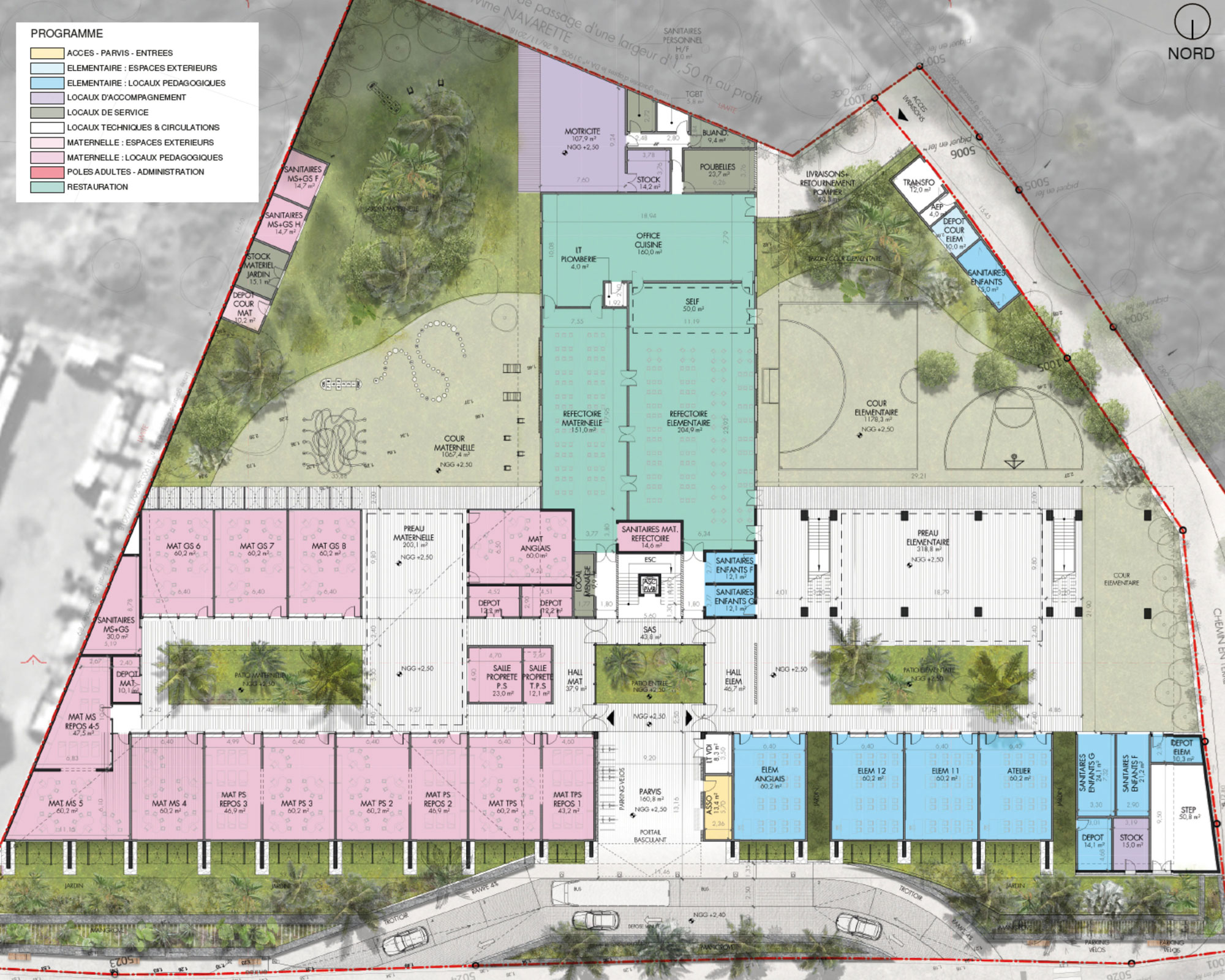
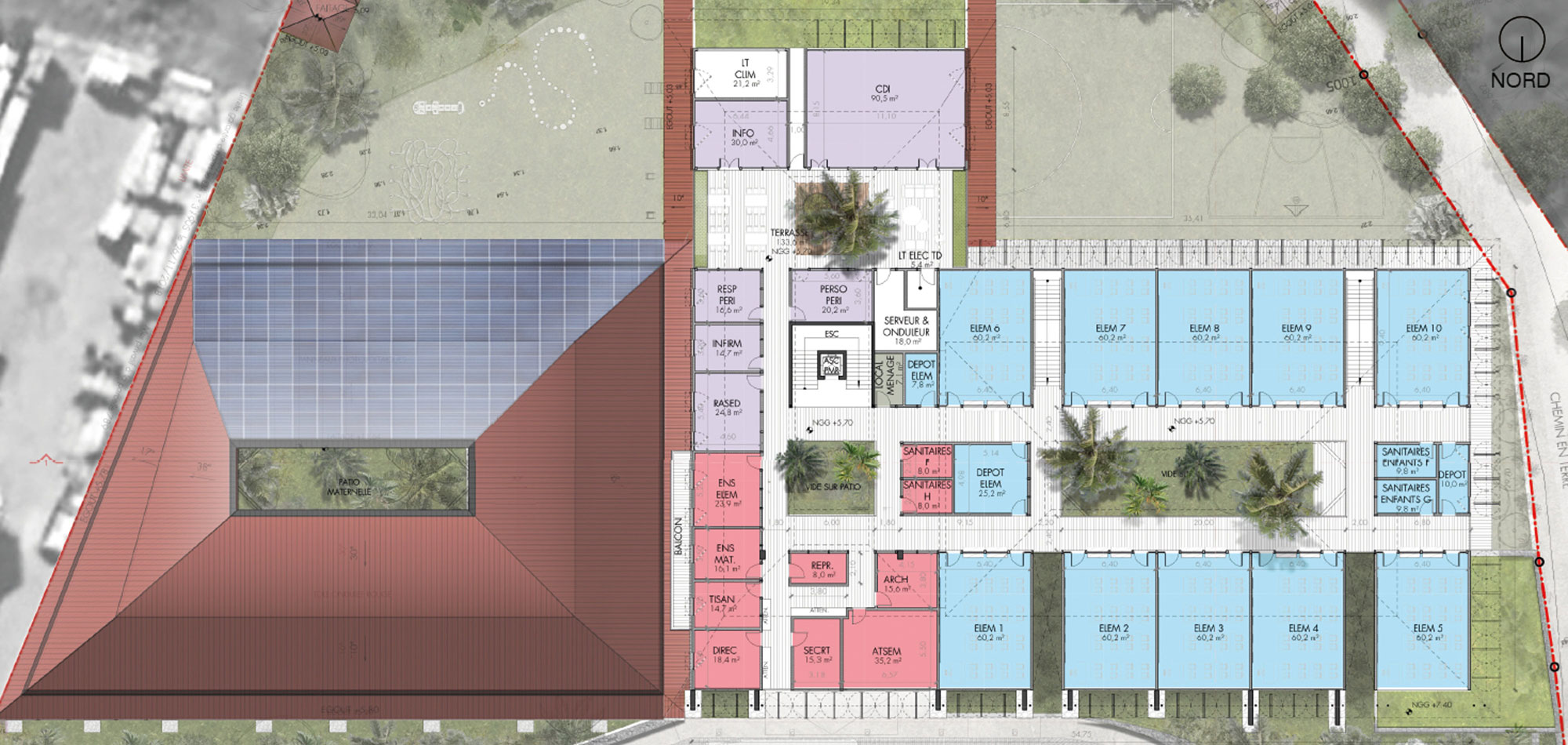
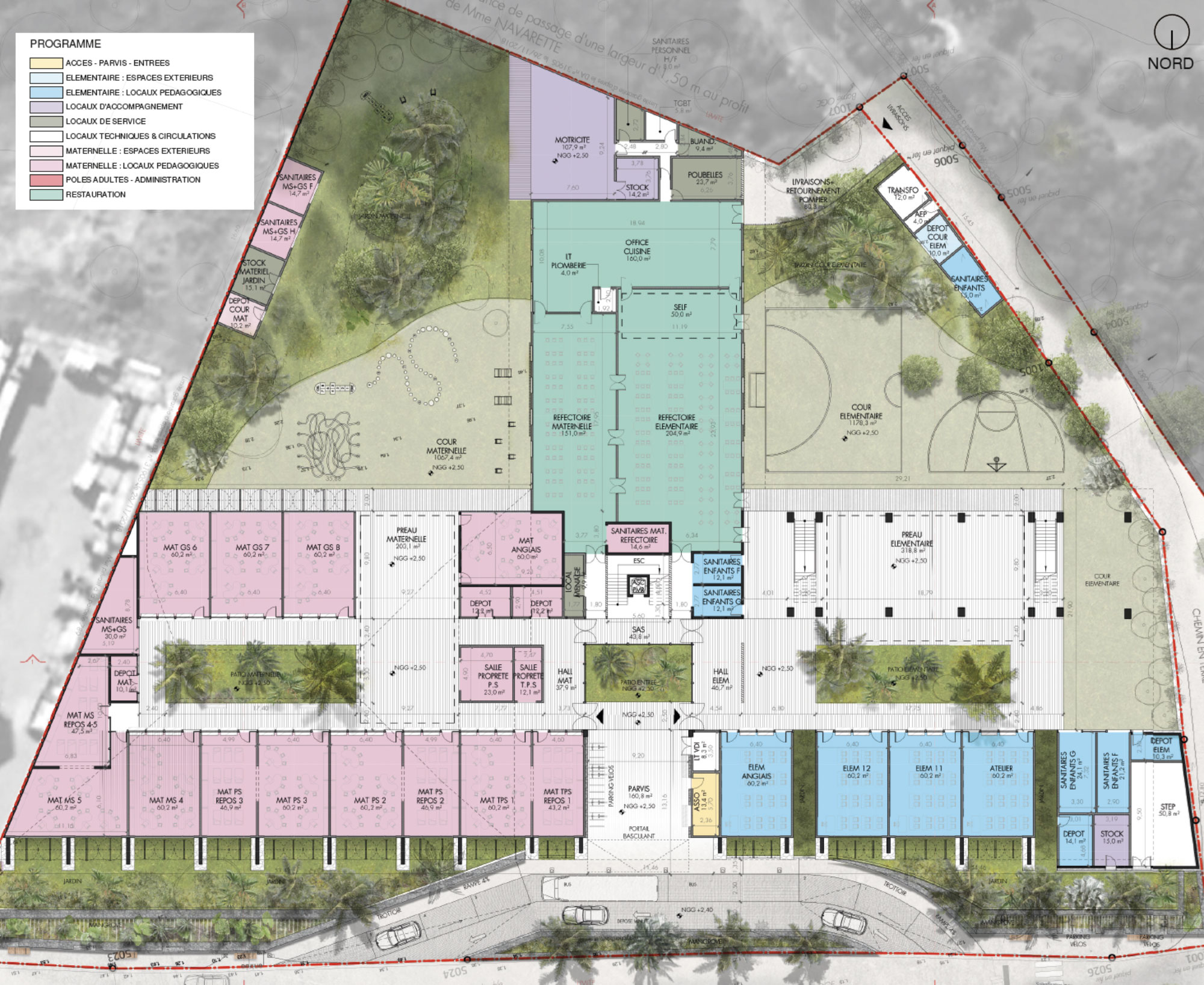
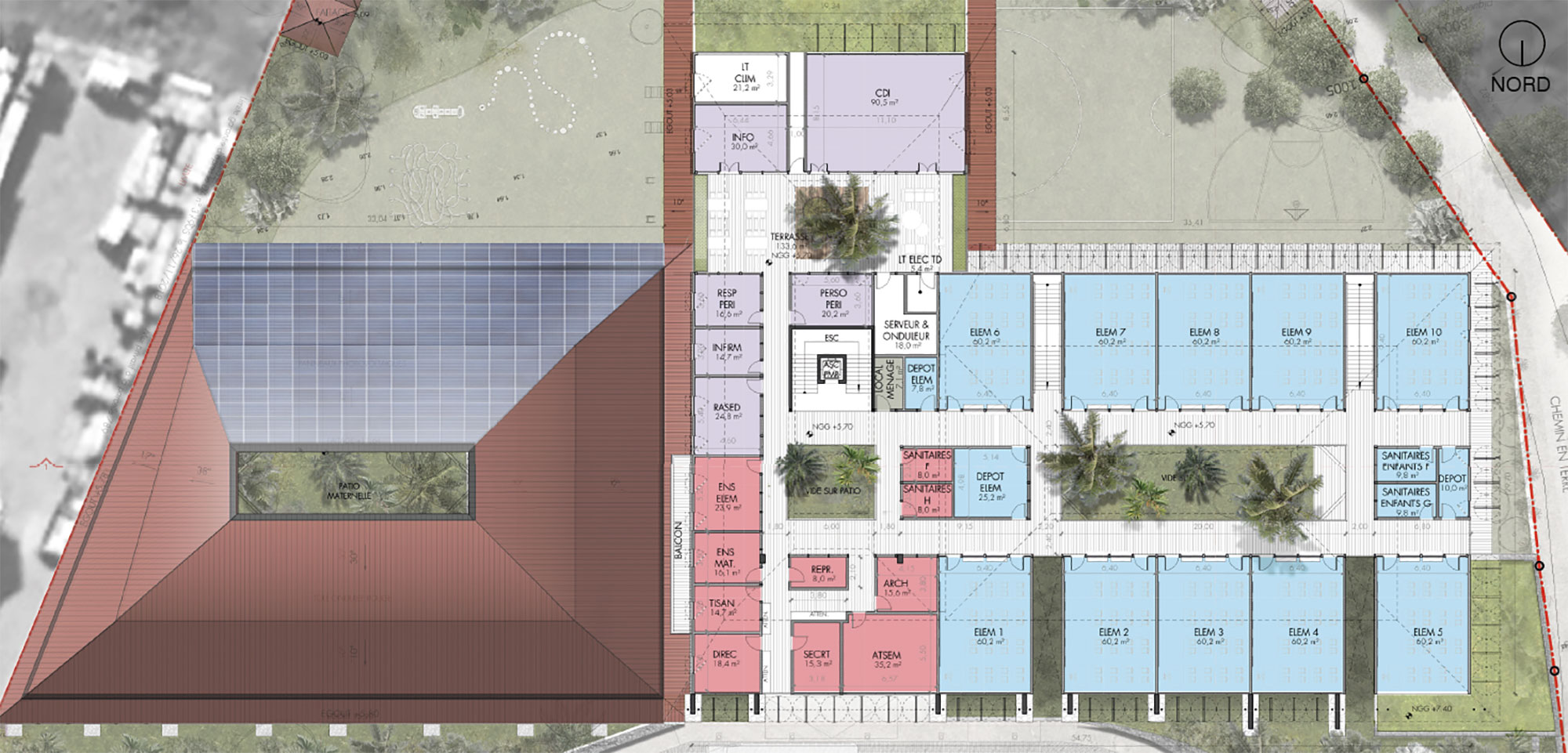
The School As A Model
A school carries a heavy responsibility as it is the first essential step in the cultural, intellectual, and spiritual development in the life of a child. Which means that a project like this has no choice than to respond to the challenges of our times, such as global warming and the lack of natural resources. As a result, this building should be a model in terms of local sustainable development, and of resistance and resilience in serving the pedagogical support of the students, while setting an example for the population. The project creates microclimates and allows for effective natural ventilation and regulation of the temperature throughout. The project encompasses two entities, the nursery school/kindergarten and the elementary school, linked by shared spaces and administrative offices in the center. The one-story nursery school/kindergarten would be separated from the elementary school by the administrative offices and spaces for school personnel and other staff. Each of the departments of the school is articulated around a dedicated patio. These patios are conceived like stacks for convective ventilation that maximize the natural ventilation at the heart of the project. These patios also guide pedestrian flow and simplify the orientation for users of the building. The project should embody a deep reflection on the management of energy and the local lifestyle. It should also be auto-sufficient in terms of electricity and even produce extra power, and have exemplary management of water on the site, in spite of the complex hydrological characteristics.
The School As A Model
A school carries a heavy responsibility as it is the first essential step in the cultural, intellectual, and spiritual development in the life of a child. Which means that a project like this has no choice than to respond to the challenges of our times, such as global warming and the rarefication of natural resources. As a result, this building should be a model in terms of local sustainable development, and of resistance and resilience in serving the pedagogical support of the students, while setting an example for the population. The project that we proposed is a manifesto of responsible bioclimatic architecture that creates microclimates and allows for effective natural ventilation and regulation of the temperature throughout. The project encompasses two entities, the nursery school/kindergarten and the elementary school, linked by shared spaces and administrative offices in the center. The one-story nursery school/kindergarten would be separated from the elementary school by the administrative offices and spaces for school personnel and other staff. Each of the departments of the school is articulated around a dedicated patio. These patios are conceived like stacks for convective ventilation that maximize the natural ventilation at the heart of the project. These patios also guide pedestrian flow and simplify the orientation for users of the building. The project should embody a deep reflection on the management of energy and the local lifestyle. It should also be auto-sufficient in terms of electricity and even produce extra power, and have exemplary management of water on the site, in spite of the complex hydrological characteristics.
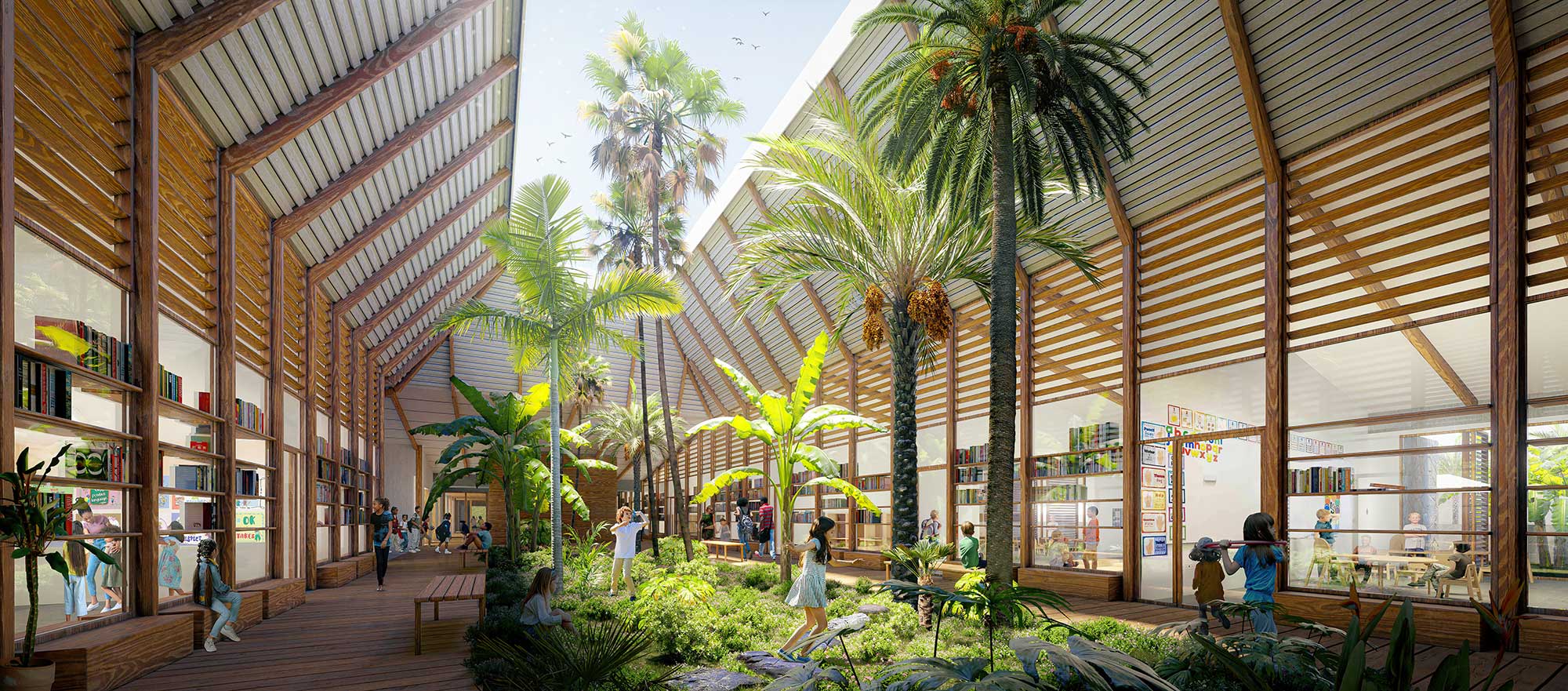
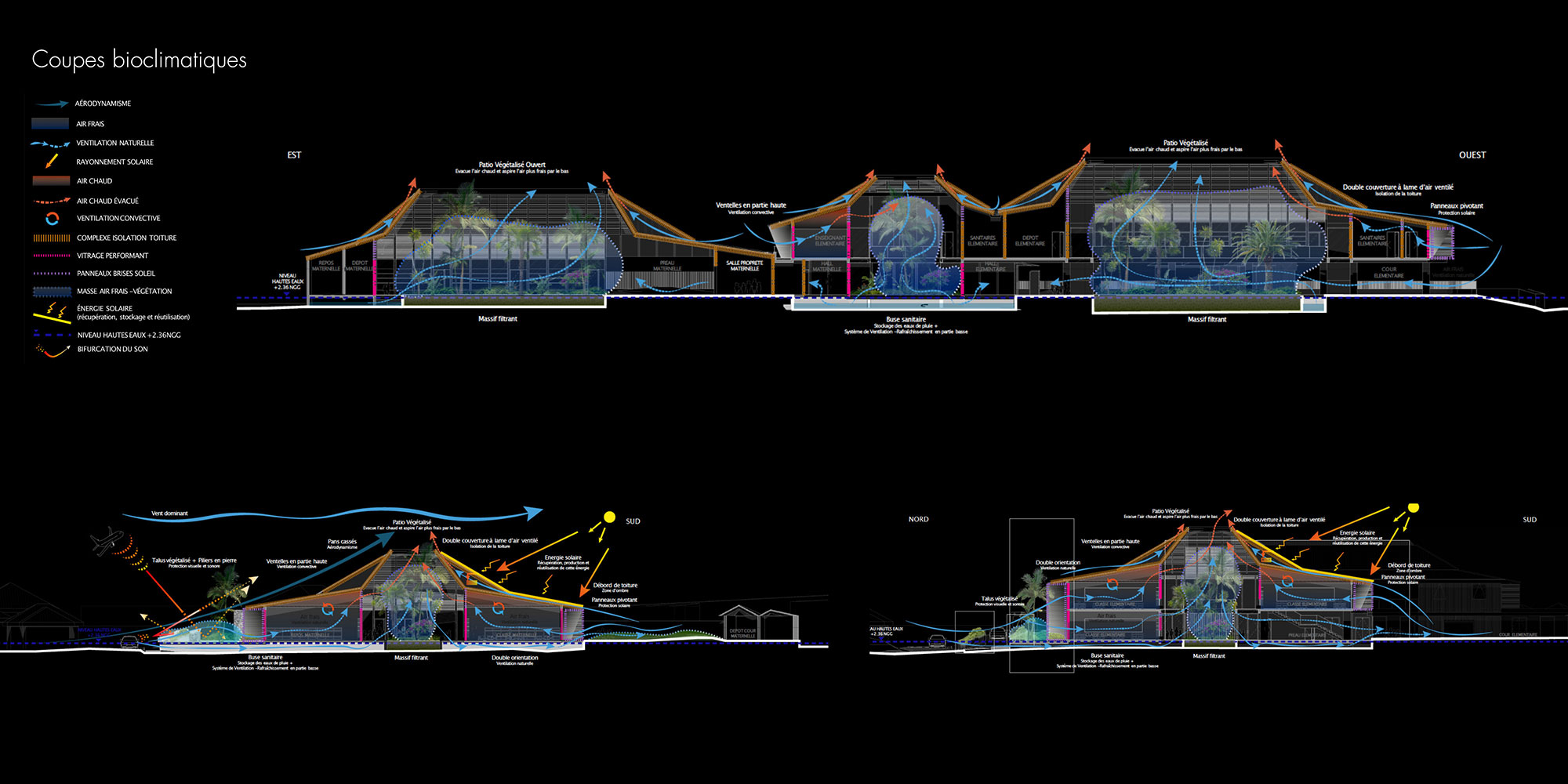
A Project That Goes Beyond Just The Land
In terms of the island, the creation of a school complex is important and indispensable. It also offers an opportunity, as the first step in the necessary decentralization of activities and institutions to the center of the island. In the case of St Barthélemy, centralizing activities around the bay of St Jean also means reducing average driving times and could thus participate in reducing traffic problems on the island. It is also a unique opportunity to ease congestion in Gustavia and reaffirm its status as the cultural and historic capital of the island. The area of St Jean is the backbone of St Barthélemy, primarily as the airport is located there, as well as the principal throughfare of the island along the bay, where there are already numerous business and tourism activities, as well as natural sites and a residential zone. Once the location of large ponds, it remains a flood zone with watersheds that surround the area, as well as a zone subject to risks of submersion and soil liquefaction. The entire area, and especially the building site in particular, has to face major hydrological challenges. The choice of this location is due to its central, strategic placement and the fact that it is the only extended flat land on the island.
The Landscape: A Heritage To Transmit
The site presents undeniable geographic advantages, but it must be integrated in the existing, complex environment that represents a mix of residential, tourism, nature, businesses, and traffic flow. It is also the most attractive and accessible area on the island and its characteristics should be preserved. The continuation of its attractiveness comprises a balance between the necessary decentralization of its activities in St Jean and the necessity of preserving its picture-postcard landscape. Our point of departure is to preserve the existing landscape and make sure that future generations would be able to enjoy it. Preserving its environment also means preserving and transmitting its culture: that is the goal of the school. As a result, the project maintains the vegetation already found on the site, as well as the continuity between the hillsides and the flatland, including the canal that runs along the parking lot for the sports stadium, a place of residence for numerous iguanas recently referenced by the territorial environmental agency. In addition to the natural landscape, the project must be integrated into the range of buildings already built nearby. It also incorporates the codes of local and traditional vernacular architecture by the way of walls made of local stone, roofs of red corrugated metal, and construction featuring wooden shutters with louvres. On the main façade, traditional stone pillars support roofs inspired by traditional stone cisterns and the old windward cottages. At the center, the project revisits the design of cottages with covered galleries, reinterpreting them with interior galleries around the patios.
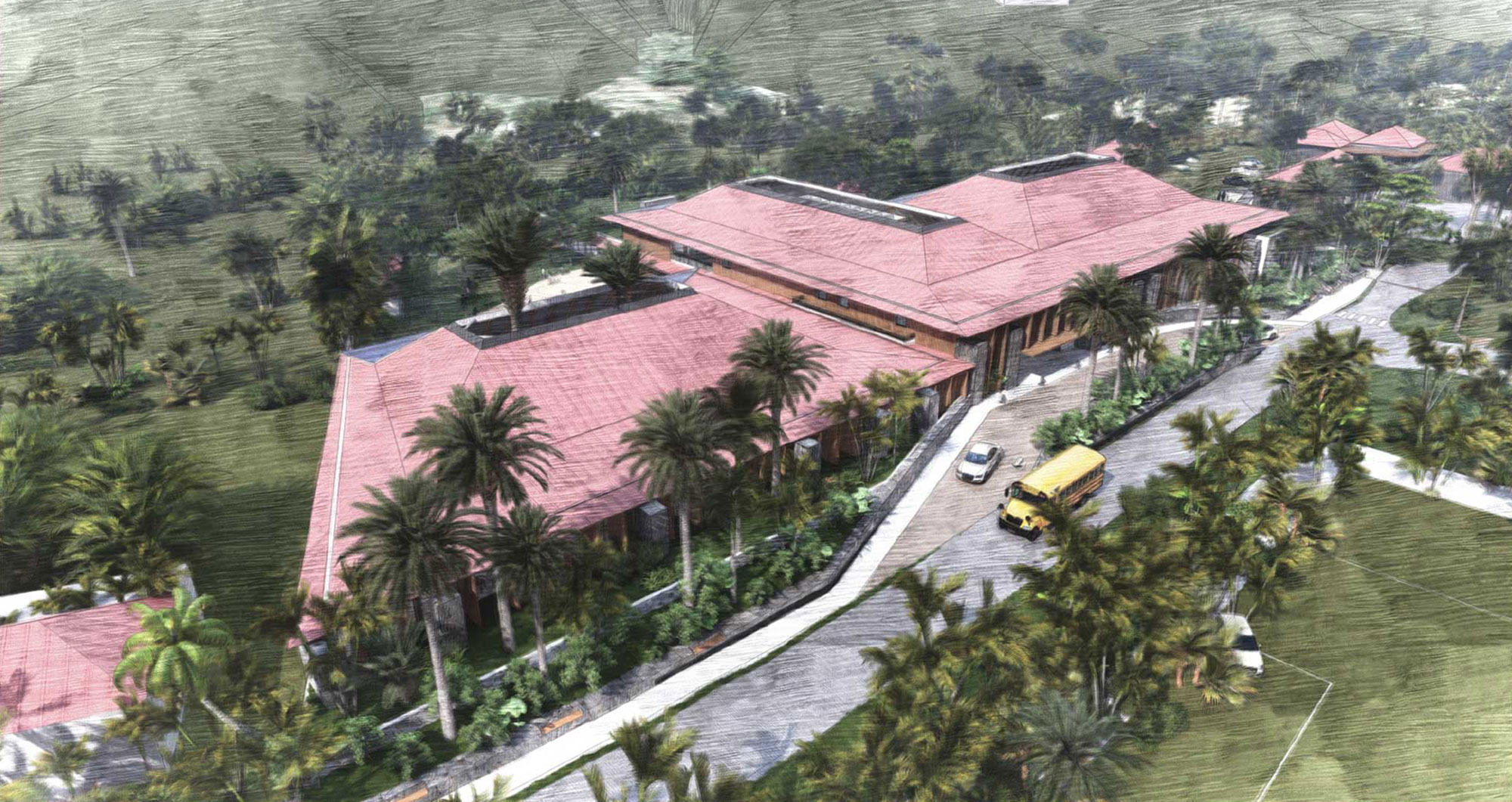
The “Central Park” Of St Barth
Preserving this landscape also means preserving empty spaces by improving them. In the neighborhood of St Jean, the site for the school complex is located on the edge of a zone that we call the “Central Park” of the island. It’s a mixed-use zone at the foot of the hillside and removed from the coast. It is a vast, extended plain, floodable, not too much existing construction, and thus important for the landscape of the bay. This “Central Park” of St Barth encompasses three existing, pivotal areas with comparable surfaces and complementary activities:
The recently renovated St Jean salt pond: the nature hub of the park;
• The sports complex with various recreational activities: the wellness and good health hub of the park;
• La Savane, Les Galeries du Commerce, and Les Mangliers: the business hub of the park.
This “Central Park” is also surrounded by homes and hotels, shops and restaurants. It can constitute an autonomous unit, and remain attractive with a master plan for this future school complex, ideally located on the edge of “Central Park,” with direct access to protected zones and installations in the park area. The school complex would be located at the frontier between the wellness hub and the business hub, along the long secure promenade we call the “Mangrove,” which leverages the existing elements of the landscape that encircle and delineate “Central Park” and lead to the site of the project.
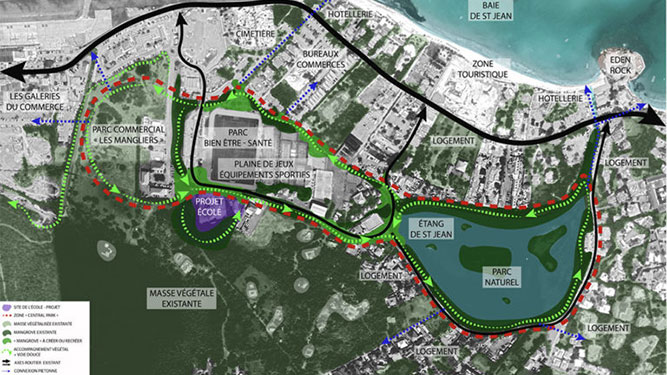
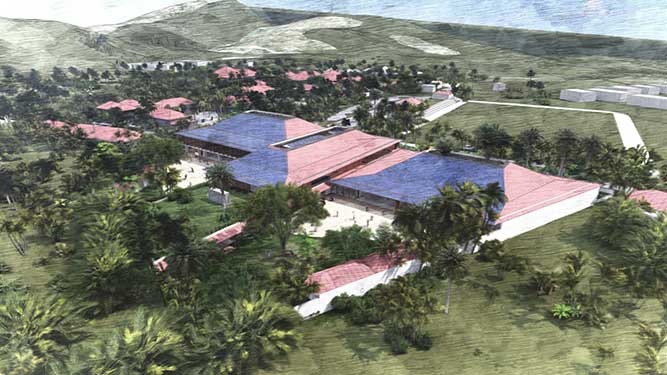
The “Central Park” Of St Barth
Preserving this landscape also means preserving empty spaces by improving them. In the neighborhood of St Jean, the site for the school complex is located on the edge of a zone that we call the “Central Park” of the island. It’s a mixed-use zone at the foot of the hillside and removed from the coast. It is a vast, extended plain, floodable, not too much existing construction, and thus important for the landscape of the bay. This “Central Park” of St Barth encompasses three existing, pivotal areas with comparable surfaces and complementary activities:
• The recently renovated St Jean salt pond: the nature hub of the park;
• The sports complex with various recreational activities: the wellness and good health hub of the park;
• La Savane, Les Galeries du Commerce, and Les Mangliers: the business hub of the park.
This “Central Park” is also surrounded by homes and hotels, shops and restaurants. It can constitute an autonomous unit, and remain attractive with a master plan for this future school complex, ideally located on the edge of “Central Park,” with direct access to protected zones and installations in the park area. The school complex would be located at the frontier between the wellness hub and the business hub, along the long secure promenade we call the “Mangrove,” which leverages the existing elements of the landscape that encircle and delineate “Central Park” and lead to the site of the project.


Create An Academic Sanctuary
If the project encompasses environmental considerations and the preservation of the landscape, it should also define a limit vis-à-vis public space. A school complex should be a sanctuary where the safety and comfort of the children is the absolute priority. As such, it should be a place naturally secure by way of its implantation and the composition of its volumes, as much for its means of access as well as its general operation. The classrooms, like the exterior spaces, should respond to the need for calm, as well as the need for natural ventilation. The proposed building stretches to the limit of the property with a protective barrier to protect all aspects of the project. The barrier will be designed to meet several needs, such as a filter that is at once porous, in terms of water from the air, or for pedestrians and vehicles approaching the building. The organization around the patios respond to the fundamental needs of the project and allow it to open toward the interior. The goal was to organize the project around the patios to create a cocoon that allows the students to concentrate. Finally, to preserve its environment, the project should be integrated naturally into the surrounding landscape, while maintaining its function as a landmark and a symbol.
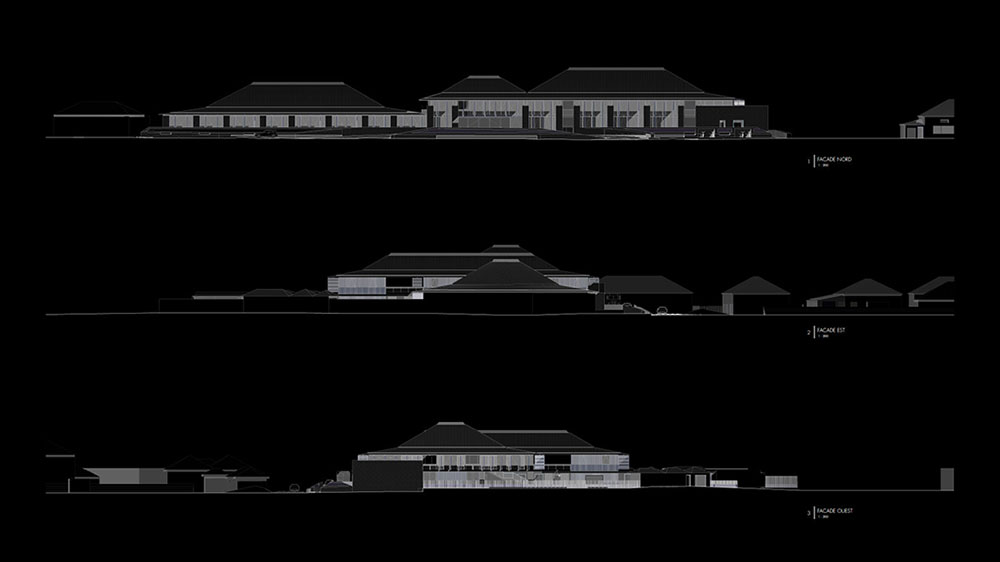
The School Of Today And Of Tomorrow
A durable building is also a flexible building that can be reutilized, developed, extended. This impacts the use of materials as well as the structural principles employed to allow the building to evolve over time and thus have several lives and uses. A building can be recycled both in terms of its use as a structure, as well as in the reuse of its materials if destroyed. This project is therefore an opportunity to transit the fundamental principles of durable development, of environmental protection, of energy frugality, autonomy, and resilience to future generations. Designing the micro-climates of the project means ensuring the comfort of those in the building throughout the year. And to rise to the occasion to meet the challenges of the 21st century and be able to provide solutions to the extreme situations that will confront future generations, for which one must provide a radical response, which we have baptized: THE THREE-PATIO SCHOOL.



